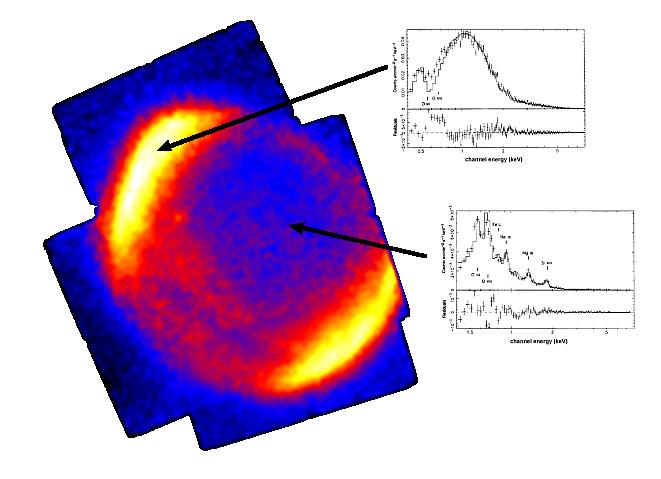
 Credit: Koyama, K., et al., Nature, 378, 255, 1995
Credit: Koyama, K., et al., Nature, 378, 255, 1995
Cosmic Ray Gun
Cosmic rays are mysterious streams of extremely fast moving subatomic
particles (mainly protons and electrons) produced in space. Astronomers
don't know precisely where all these particles come from. The sun is a
known source of cosmic rays which are produced by high energy explosions
(solar
flares) in the sun's atmosphere, but the amount of cosmic rays emitted
by the sun is too low to account for all the cosmic rays which strike
earth. Astronomers for a long time have suspected that supernova explosions
might be an important source of cosmic rays in the Galaxy. In a supernova,
an enormous amount of material is exploded from a dying star; as this
material encounters the surrounding gas in the galaxy, it produces a strong
shock which might accelerate protons and electrons into cosmic rays.
Observations by the ASCA satellite
for the first time provided direct evidence that supernova actually do
produce cosmic rays. The image on the above left shows an ASCA observation
of the supernova remnant SN
1006. Measurements of the X-ray emission in the supernova remnant
showed startling variations in the types of X-rays produced in the
different parts of the remnant. The inset graph of the X-ray energy
spectrum in the lower right tells astronomers that inside the remnant,
X-rays are produced by hot gas. However, the graph of the X-ray spectrum of
the bright edge of the remnant tells astronomers that the X-ray emission in
the bright rim is produced by fast moving electrons spiralling around
magnetic field lines. These electrons must have been accelerated by the
blast wave from the supernova, showing that supernova explosions can indeed
be a source of cosmic rays.
Last Week *
HEA Dictionary * Archive
* Search HEAPOW
* Education
Each week the HEASARC
brings you new, exciting and beautiful images from X-ray and Gamma ray
astronomy. Check back each week and be sure to check out the HEAPOW archive!
Page Author: Dr. Michael F.
Corcoran
Last modified November 9, 2000


